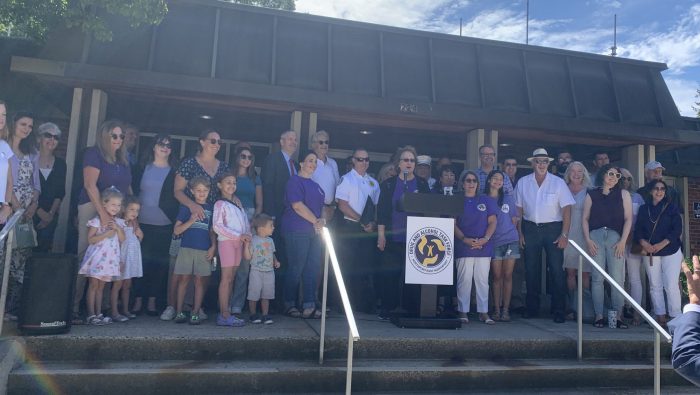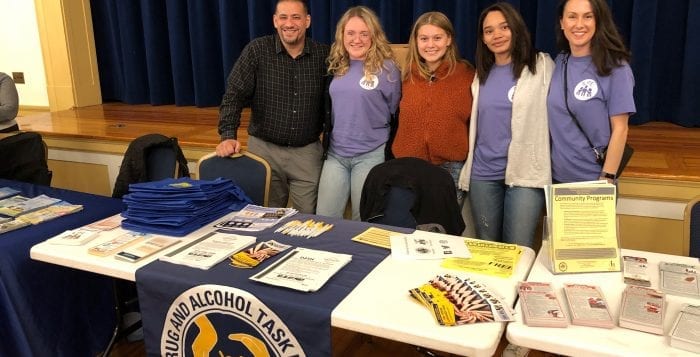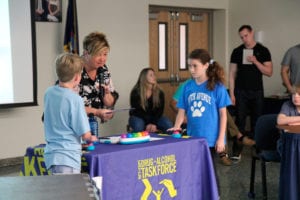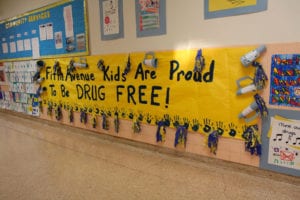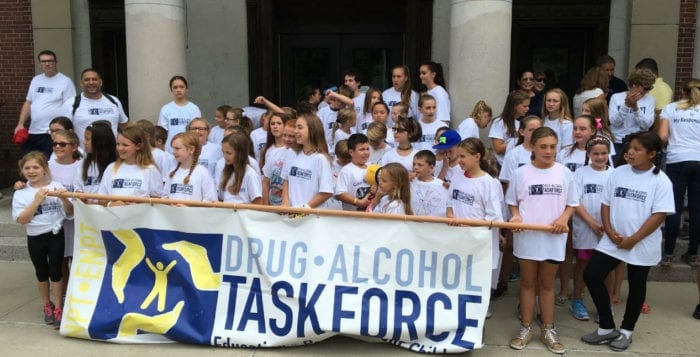In 2006, at the age of 21, two young adults in Northport died of an opioid overdose. To honor these lives and help prevent other overdoses and addictions, the Northport community created the Drug and Alcohol Task Force. The program today has evolved into a very exciting part of the community. TBR News Media would like to recognize the efforts of all those involved in their community’s drug prevention efforts.
In 2017, after being awarded a Drug-Free Community grant, the Northport/East Northport Drug and Alcohol Task Force created a youth coalition, called 1LIFE, and hired social worker Catherine Juliano to develop the curriculum.
“Everything we do focuses on health, wellness, kindness and connection,” Juliano said.
“We want to let people know that it’s OK to ask for help.”
– Catherine Juliano
The idea is to empower teenagers and build their leadership skills so they can identify issues impacting the community. Once the group zeros in on a concern, they strategize and implement an action plan.
“The kids are very smart,” said Juliano, a 2007 graduate of Northport High School. “If you only say: ‘Don’t do drugs,’ people will be turned off.”
She meets once a week with a core group of 25 kids and together they talk about issues that impact their peers. In 2018, the coalition sponsored a mental health awareness day. This year it became a mental health awareness week, which was comprised of a series of speakers. They sponsored an after-school retreat to teach coping skills that included using music, yoga and meditation to reduce or eliminate stress. More than 250 students attended.
“It should be all year,” Juliano said. “We show students that teenagers struggle, and mental health is real. The idea is to promote self-care health and wellness.”
The program also informs students about the school’s resource center, which includes free counseling services with access to a drug and alcohol counselor. Reducing stigma, creating a culture that sees addiction as a disease, is part of their mission. The program helps students identify feelings and teaches how to reduce stress in themselves and recognize the qualities in others.
“We want to let people know that it’s OK to ask for help,” Juliano said.
Town Councilman Mark Cuthbertson (D) said the program is making a difference.
“Since 2006, the task force has made a big impact in our town,” he said. “Working together with students, parents and educators, they have successfully engaged the community to reduce the use of drugs.”
Developing healthy relationships is also part of the curriculum.
Every year for the last three years, the group has pulled together a community fundraiser called The Color Run. Students dress in light-colored clothing and traverse a trail, where they encounter event sponsors, typically community groups, who ultimately splash them with colored cornstarch in spray bottles. Last year, more than 700 people participated in The Color Run.
“It’s such a great thing,” said Juliano. “Kids find it thrilling; elementary kids are running around and want to be sprayed.”
The money they raise is used to support the coalition’s activities.
They are currently planning a workshop for fifth-graders on how to use technology in a safe way.
Juliano and her co-chair, Anthony Ferrandino, also implemented a popular Family Feud night, morphing the Too Cool for Drugs curriculum into a trivia game show with two tables of fifth-graders. A high school student dresses up like Steve Harvey to MC the event.
1LIFE also partners with the local library and Suffolk County police to coordinate a medication take-back, which gets unused pills out of the home for safe disposal.
It also does environmental cleanups at known hidden drinking areas, documents paraphernalia that is found and shares the data with the adult task force. The aim is figuring out ways to prevent kids from going back to that spot.
Ultimately, they are teaching children to make healthy choices: Instead of drugs, let’s do something else.
The Faces of Addiction
For many Long Island families whose members are struggling with an opioid addiction, recovery can seem like an endless financially and emotionally draining cycle of rehabs and relapses. Increasingly, though, people who have miraculously overcome their own narcotic dependencies are openly sharing their stories to deliver a welcomed message of hope and a promise of freedom.
Their testimonies are among society’s most effective tools to beat this epidemic. As one reformed narcotic user put it, “If you could see inside my head you would see the light bulb. It finally hit me: I needed to listen to other recovered people and rely on their guidance.”
We would like to recognize a few of the many people in our circulation area who have overcome their addiction, their sponsors and the families and organizations that have supported everyone’s efforts as People of the Year.
“Yes, It is possible to recover, and it is so worth it.”
– Chase Bernstein
Some reformed narcotic users were teenagers struggling with anxiety who started drinking alcohol or experimenting with drugs at a time when powerful opioids were abundantly dispensed, hooking many young children. Others sought relief from chronic physical pain often caused by injuries and accidents. Each circumstance is unique. So is their recovery story. Success, though, has a common denominator: It is often spiritual in nature. The virtues of faith, hope and charity play a role.
Chase Bernstein lost his father one year ago. He now works as a behavioral health technician and is one year sober. His entire recovery and his quality of life, he said, rest on his spiritual frame of mind. If he doesn’t pray in the morning, it impacts his whole day.
“Yes, IT IS POSSIBLE to recover, and it is SO WORTH IT,” he said. “I am a member of an anonymous 12-step fellowship and owe my life to the program. If it wasn’t for the steps, my sponsor, the meetings and helping other people even when I’m not getting paid, I would be dead, in the hospital, in jail, or … and I think this would be the worst of any of them: still actively using.”
Bernstein finds sobriety thrilling.
“My life isn’t boring or bland, it is fulfilling and exciting, another misconception I had about sobriety,” he said. “I’ve started working at a job I love, I have friends, my family relationships have never been better, and I’ve even been able to experience the trials and tribulations of dating, while in recovery as a young person.”
Another reformed narcotic user, Sarah Smith, was addicted to opioids and alcohol as a young teenager. Today, eight years sober, she works full time as a treatment specialist. Helping others has given her life deeper meaning.
“I don’t know if I would have stayed sober, if I wouldn’t have had this sense of purpose,” she said.
In high school, Smith was an all-county champion softball catcher. Two years ago, she had the idea to form a softball team comprised of people recovering from narcotics use. She pulled a team together, with the help of Will Astacio, who worked at the time as a peer-to-peer mentor for veterans combating depression, anxiety and substance abuse issues. People were so enthusiastic they managed to form two different teams. With Smith as captain, the team, called THRIVE , won the 2019 county title.
“If it wasn’t for Sarah, they wouldn’t have won the championship,” Astacio said. “She’s great at bringing people together.”
Sarah also regularly advises elected officials who want to know what they can do to help address the epidemic. Her recommendations in a nutshell: more access to effective treatment, more emphasis on continuity of care, removal of insurance obstacles and offering more jobs and better pay to mental health professionals. In regard to legalizing marijuana, her advice is a firm NO.
Medical schools are also relying on reformed narcotic users to inform their curriculum.
This past summer Stony Brook University’s medical school invited several recovered narcotic users to act as teachers. One eloquent speaker, who wants to remain anonymous so we’ll call her Claire, shared her story with first-year medical students. The session was impactful, according to Dr. Lisa Strano-Paul, the assistant dean of the medical school. She expects the instruction to stick with the medical students their whole life. Claire also found the experience rewarding.
Recovery, she said, is miraculous.
She doesn’t consider herself a religious person but said that the power of prayer somehow opens you up. She came to terms with her own spirituality by appreciating the awe of nature.
Recognizing your own self-centeredness also prompts you to change, she said. It’s a key part of the 12-step program.
Bernstein has also found this to be important, “There’s a popular line from a Biggie Smalls song that goes something like ‘check yourself before you wreck yourself.’ I think about that line all the time. I know it sounds corny that an old rap lyric helps me in my recovery, but it does! If I leave my motives unchecked, I start to make selfish and careless decisions without regard for the people in my life.”
This type of mindfulness is also used in cognitive behavioral therapy. Often called CBT, it also incorporates being honest, goal setting, establishing incremental steps toward reaching a goal, rewarding or celebrating successes and verbalizing happiness.
Patricia Tsui practices nonpharmacological approaches to pain at Stony Brook University Hospital’s pain center and has helped Long Islanders overcome addiction after they were prescribed narcotics for chronic pain.
Artemis Shepard and Nick Giulintano are among her patients. Shepard suffered with three herniated discs and couldn’t get out of bed. Giulintano worked as a construction laborer for 30 years. He was seriously injured in a four-car collision driving at 60 mph. He was given bags of medicine, he said, including opioids that he took “like tic tacs.”
“You get used to taking medication and the induced-high,” Shepard said. “But it changes you.”
She lost friendships and developed kidney disease, she said, from the medication. Their quality of life without narcotics, they both agree, is far more satisfying.
Giulintano now has a spinal implant, which has helped with the chronic pain. In group talk sessions at the pain center, they ultimately found alternate ways to cope to overcome their addiction.
Talking with the group at the pain center was an important part of their healing.
“I know, I’m not the only one,” Giulintano said. “And I’m always happy helping other people.”
This tribute is for them and for all the other unnamed people who shared their recovery story with our newspaper and all the people hoping for recovery. Help is a phone call away.
The 24/7 hot line is 631-979-1700.
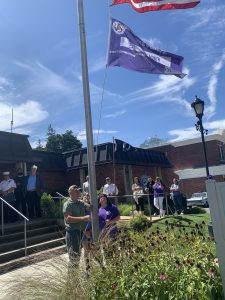 “Before we can ask for bail, you would have to have enough fentanyl to kill 134,000 people,” he said. “We shouldn’t have to wait for someone to die before we can take them off the street,” adding, “That is unconscionable in the face of an epidemic.”
“Before we can ask for bail, you would have to have enough fentanyl to kill 134,000 people,” he said. “We shouldn’t have to wait for someone to die before we can take them off the street,” adding, “That is unconscionable in the face of an epidemic.”
